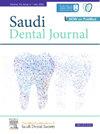含氟预载埃洛石纳米管在传统和树脂改性玻璃离子聚合物水门汀中增强氟释放的体外研究
IF 2.3
Q3 DENTISTRY, ORAL SURGERY & MEDICINE
引用次数: 0
摘要
该研究的目的是比较两种传统玻璃离子聚合物水门汀(Ionobond、Ketac Molar)和两种树脂改性玻璃离子聚合物水门汀(Vitrebond、Fuji II LC)中氟化钠的释放情况。制备样品所需的离子聚合物粉末总重量的 10 % 和 5 % 分别被预载了 2,000 ppm 的纳米管所取代。对实验组进行了为期 120 天的跟踪观察,每次间隔 7 天。所有实验组与对照组相比都有显著差异;同样,5% 和 10% 浓度的实验组之间也有差异。本文章由计算机程序翻译,如有差异,请以英文原文为准。
An in vitro study of fluoride-preloaded halloysite nanotubes to enhance the fluoride release in conventional and resin-modified glass ionomer cements
Objective
The purpose of the study was to compare the fluoride release in two conventional glass ionomer cements (Ionobond, Ketac Molar) and two resin-modified glass ionomer cements (Vitrebond, Fuji II LC) adapted with halloysite nanotubes preloaded with sodium fluoride at different concentrations.
Methods
In total, 96 samples were prepared and distributed into four control groups and eight experimental groups (5 % and 10 %). Totals of 10 % and 5 % of the total weight of ionomer powder needed to prepare the samples were replaced with nanotubes, preloaded at 2,000 parts per million, respectively. The experimental groups were followed for 120 days at seven time intervals. All the samples were stored at 37 °C.
Results
All the experimental groups showed significant differences compared with the control groups; likewise, differences were observed between the concentrations of 5% and 10%.
Conclusion
The experimental groups (conventional and resin-modified glass ionomer cements adapted with preloaded nanotubes) released a higher and more constant amount of fluoride compared to the control groups.
求助全文
通过发布文献求助,成功后即可免费获取论文全文。
去求助
来源期刊

Saudi Dental Journal
DENTISTRY, ORAL SURGERY & MEDICINE-
CiteScore
3.60
自引率
0.00%
发文量
86
审稿时长
22 weeks
期刊介绍:
Saudi Dental Journal is an English language, peer-reviewed scholarly publication in the area of dentistry. Saudi Dental Journal publishes original research and reviews on, but not limited to: • dental disease • clinical trials • dental equipment • new and experimental techniques • epidemiology and oral health • restorative dentistry • periodontology • endodontology • prosthodontics • paediatric dentistry • orthodontics and dental education Saudi Dental Journal is the official publication of the Saudi Dental Society and is published by King Saud University in collaboration with Elsevier and is edited by an international group of eminent researchers.
 求助内容:
求助内容: 应助结果提醒方式:
应助结果提醒方式:


